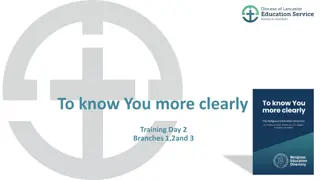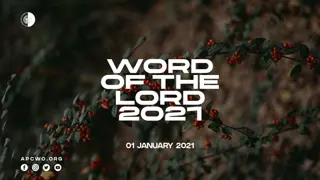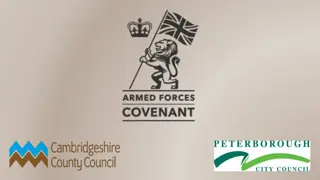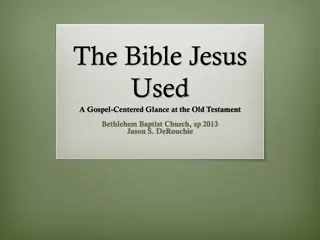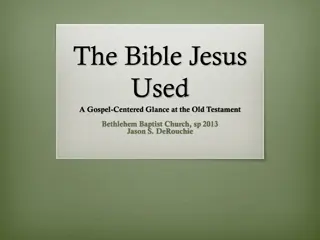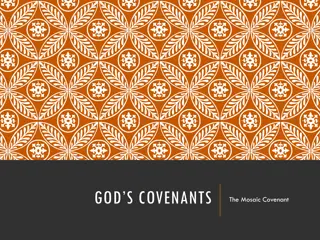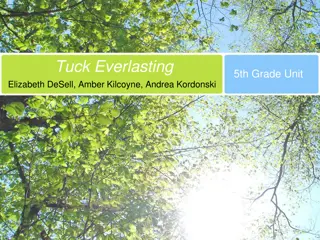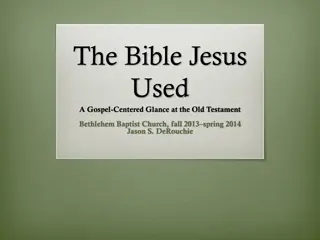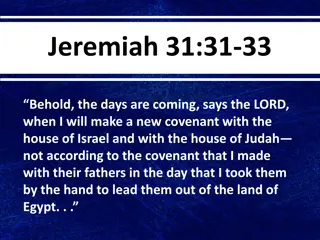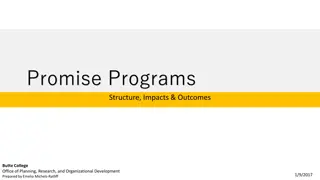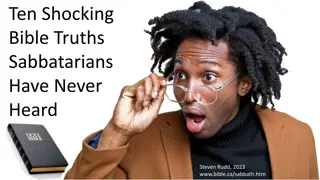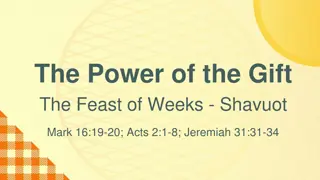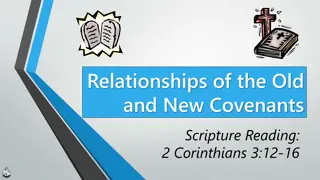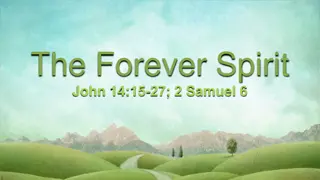The New Covenant: Understanding the Everlasting Promise
Significance of the New Covenant in contrast to the Everlasting Covenant, this lesson delves into the similarities and differences between the two agreements. Discover how the New Covenant brings better promises, sacrifices, and priesthood, while maintaining the same foundation and authorship. Through prophetic insights from Jeremiah and Ezekiel, witness the renewal and fulfillment of God's covenant with His people, emphasizing His forgiveness, mercy, and unchanging relationship with them.
Download Presentation

Please find below an Image/Link to download the presentation.
The content on the website is provided AS IS for your information and personal use only. It may not be sold, licensed, or shared on other websites without obtaining consent from the author.If you encounter any issues during the download, it is possible that the publisher has removed the file from their server.
You are allowed to download the files provided on this website for personal or commercial use, subject to the condition that they are used lawfully. All files are the property of their respective owners.
The content on the website is provided AS IS for your information and personal use only. It may not be sold, licensed, or shared on other websites without obtaining consent from the author.
E N D
Presentation Transcript
THE NEW COVENANT Lesson 10 for June 5, 2021
In previous lessons, we learned that God established an Everlasting Covenant. Then why are we talking about a New Covenant in this lesson? What is the difference between this new covenant and the old one? Are they similar?
Whats OLD in the new covenant? Same Author, same Law Same relationship Same purpose What s NEW in the new covenant? Better covenant, better promises Better sacrifice, better priesthood
MEMORY TEXT Behold, the days are coming, says the Lord, when I will make a new covenant with the house of Israel and with the house of Judah Jeremiah 31:31
While Jeremiah was prophesying from Jerusalem, Ezekiel was prophesying from Babylonia where he was in captivity. Notice his comments, and compare them with Jeremiah s. Then I will give them one heart, and I will put a new spirit within them, and take the stony heart out of their flesh, and give them a heart of flesh, (Ezekiel 11:19) I will give you a new heart and put a new spirit within you; I will take the heart of stone out of your flesh and give you a heart of flesh. (Ezekiel 36:26)
SAME AUTHOR, SAME LAW The people of Israel had broken their covenant with God because of their unfaithfulness. Therefore, Jeremiah prophesized a new covenant between God and His people. However, there are elements that stay the same in this new covenant: The new covenant is a renovated covenant in some way. It is the culmination or the fulfilment of the first one.
SAME AUTHOR, SAME LAW The same Author God is the creator of the covenant The same Law The Law of God is the basis of the covenant The same foundation It is based on God s forgiveness and mercy
SAME RELATIONSHIP I will betroth you to Me in faithfulness, and you shall know the Lord. (Hosea 2:20) The people of Israel had been unfaithful to God, but He wanted to renew their relationship. That is what the new covenant is about: God wants to win our hearts again.
SAME RELATIONSHIP He wants us to renew our thoughts and feelings: I will put My law in their minds, and write it on their hearts (Jeremiah 31:33); get yourselves a new heart and a new spirit (Ezekiel 18:31); I will give you a new heart and put a new spirit within you (Ezekiel 36:26). Nevertheless, this is not a new purpose. It is the same relationship that God wanted to have with His people since the beginning: And these words which I command you today shall be in your heart. (Deuteronomy 6:6)
SAME RELATIONSHIP The purpose of the sanctuary was to take care of the sin problem so that God could dwell with His people. The purpose of the New Covenant is to take care of the sin problem so that God can dwell with His people. Quote from Sabbath School Study Hour.
SAME PURPOSE Also the sons of the foreigner Who join themselves to the Lord, to serve Him, And to love the name of the Lord, to be His servants Everyone who keeps from defiling the Sabbath, And holds fast My covenant Even them I will bring to My holy mountain, and make them joyful in My house of prayer. Their burnt offerings and their sacrifices will be accepted on My altar; for My house shall be called a house of prayer for all nations. (Isaiah 56:7)
SAME PURPOSE God wanted to invite all the nations to be part of His promises. This was at the core of His covenant with Israel. The new covenant has the same purpose. The grace of God is available for anyone who wants it through the blood of Jesus (Romans 3:21-24).
SAME PURPOSE But now the righteousness of God apart from the law is revealed, being witnessed by the Law and the Prophets, even the righteousness of God, through faith in Jesus Christ, to all and on all who believe. For there is no difference; for all have sinned and fall short of the glory of God, being justified freely by His grace through the redemption that is in Christ Jesus. (Romans 3:21-24)
SAME PURPOSE The Jews who accepted Jesus embraced this new covenant and built the foundation of the Church. Later, Gentiles from every nation joined the covenant and were grafted into the true people of God (see Romans 11:1-24).
The book of Hebrews explains how Jesus fulfilled the prophecy of the new covenant in Jeremiah 31:31- 34. It also explains the differences between the two covenants. Why is the new covenant better than the old one?
Hebrews 8:1-8 1 Now this is the main point of the things we are saying: We have such a High Priest, who is seated at the right hand of the throne of the Majesty in the heavens, 2 a Minister of the sanctuary and of the true tabernacle which the Lord erected, and not man.
For every high priest is appointed to offer both gifts and sacrifices. Therefore it is necessary that this One also have something to offer. For if He were on earth, He would not be a priest, since there are priests who offer the gifts according to the law; who serve the copy and shadow of the heavenly things, as Moses was divinely instructed when he was about to make the tabernacle. For He said, See that you make all things according to the pattern shown you on the mountain. But now He has obtained a more excellent ministry, inasmuch as He is also Mediator of a better covenant, which was established on better promises. (v.3-6)
For if that first covenant had been faultless, then no place would have been sought for a second. 8 Because finding fault with them, He says: Behold, the days are coming, says the Lord, when I will make a new covenant with the house of Israel and with the house of Judah (v.7-8)
The old covenant used symbols to explain salvation. In the new covenant, no symbols are needed, because Jesus died for our sins and intercedes on our behalf before the Father . Therefore He is also able to save to the uttermost those who come to God through Him, since He always lives to make intercession for them. (Hebrews 7:25)
Why are the new promises better? Salvation is the same in both covenants, but the old one was based on a future promise. The new covenant is based on a promise that Christ has already fulfilled. But Christ came as High Priest of the good things to come, with the greater and more perfect tabernacle not made with hands, that is, not of this creation. Not with the blood of goats and calves, but with His own blood He entered the Most Holy Place once for all, having obtained eternal redemption. (Hebrews 9:11-12)
BETTER SACRIFICE, BETTER PRIESTHOOD Therefore, in all things He had to be made like His brethren, that He might be a merciful and faithful High Priest in things pertaining to God, to make propitiation for the sins of the people. For in that He Himself has suffered, being tempted, He is able to aid those who are tempted. (Hebrews 2:17)
BETTER SACRIFICE, BETTER PRIESTHOOD The sacrifices of the old covenant could not actually clean the sins of the offerors or sanctify them. For the law, having a shadow of the good things to come, and not the very image of the things, can never with these same sacrifices, which they offer continually year by year, make those who approach perfect. For then would they not have ceased to be offered? For the worshipers, once purified, would have had no more consciousness of sins. But in those sacrifices there is a reminder of sins every year. For it is not possible that the blood of bulls and goats could take away sins. (Hebrews10:1-4)
BETTER SACRIFICE, BETTER PRIESTHOOD However, the sacrifice of Christ in the new covenant can remove our sins and sanctify us. By that will we have been sanctified through the offering of the body of Jesus Christ once for all. And every priest stands ministering daily and offering repeatedly the same sacrifices, which can never take away sins. But this Man, after He had offered one sacrifice for sins forever, sat down at the right hand of God, from that time waiting till His enemies are made His footstool. For by one offering He has perfected forever those who are being sanctified. (Hebrews10:10-14)
BETTER SACRIFICE, BETTER PRIESTHOOD Likewise, there were priests in the old covenant who were not perfect and had to be replaced by the following generations. In the new covenant, Jesus is High Priest forever (Heb. 6:20). Besides, He serves as such in Heaven. The veil of the Most Holy Place was torn when Jesus died (Matthew 27:51). This incident marked the transition from symbols to reality, from the old covenant to the new one.
The End These slides have been adapted from those prepared by Sergio Fustero and Eunice Laveda, members of the Seventh-Day Adventist Church in Spain. The originals can be found at https://www.fustero.es/index_en.php A copy of my expanded version can be found at www.thornleighadventist.org.au/ss_adult.htm



